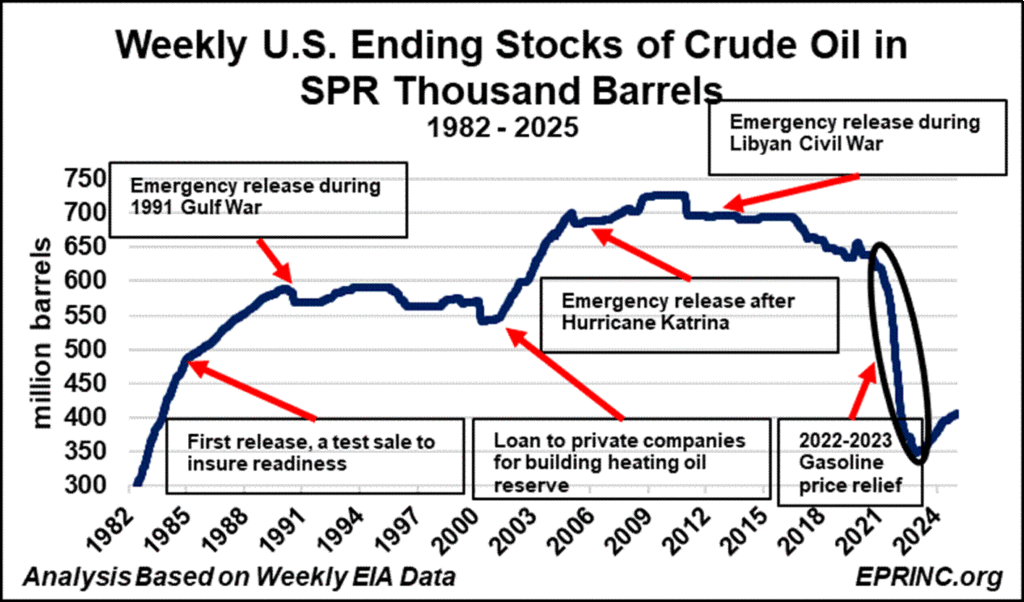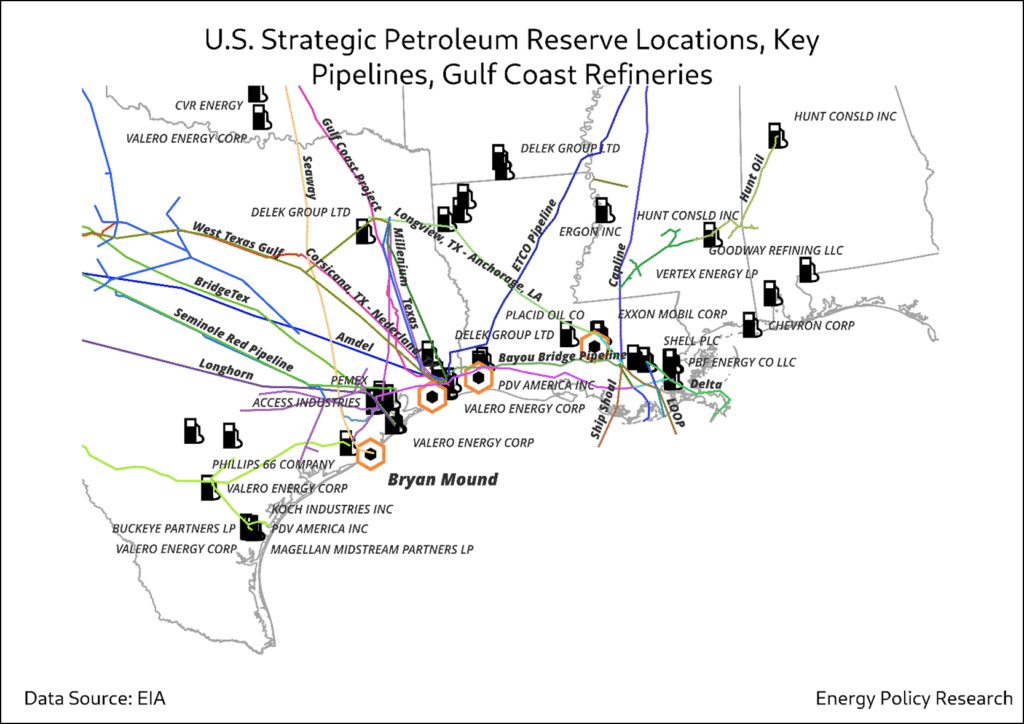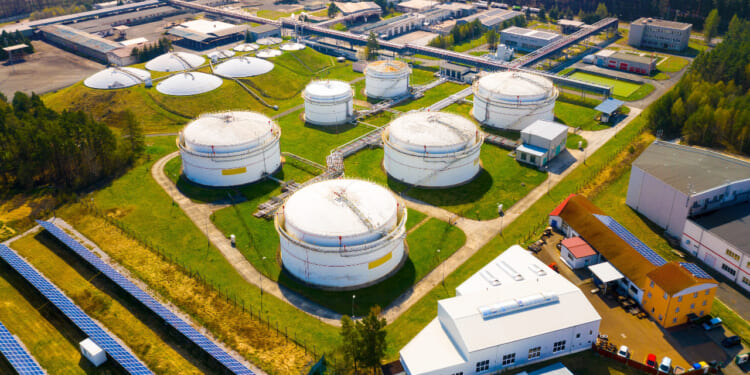As the inception of the Strategic Petroleum Reserve has reached a critical milestone, it is time to take stock of where has been and where it is going.
Beginning in November 2020, US transportation fuel prices climbed rapidly, rising to levels not seen in almost a decade. On November 23, 2021, the Biden Administration announced the release of 50 million barrels (MBs) from the US Strategic Petroleum Reserve (SPR), aiming to signal policy-based relief. These announcements and actions continued for almost a year and a half, with the last release being in March 2023.
The 2021-2023 drawdown was the largest in the SPR’s history, depleting it by over one-third and exceeding the next largest release by a factor of almost ten. While modestly replenished with 50 MBs since then, this has left the SPR with an inventory of approximately 400 MBs, down over 50 percent from its peak of 726 MBs (Figure 1).
Figure 1

Image Courtesy of EPRINC.
Rationale, History, and Current Status
On October 19, 1973 (approximately 50 + 2 years ago), the six-month Arab Oil Embargo began. The embargo was imposed by a coalition of Arab OPEC members against the United States and other allies for their support of Israel in the Arab-Israeli war that took place from October 6 to October 25, 1973.
Constituencies within the policymaking community had already recognized the potential vulnerability to growing US crude oil import dependency, rising from 8.25 percent of total crude oil supplies in 1950 to 26 percent in 1973. A variety of regulatory measures had already been introduced attempting to abate the United States’ rising import dependency, notably the 1959 Mandatory Oil Import Quota Program.
While the supply disruption from the embargo lasted six months, it led to oil price increases and an economic decline among developed countries that extended considerably past the embargo. It also signaled a critical shift in oil markets. The world had entered an era where future oil supplies would be driven by alliances such as OPEC, rather than commercial market signals.
With the economic shock from the embargo, US political leaders set out to enact a myriad of new policies with the passage of the 1975 Energy Policy and Conservation Act (EPCA). The EPCA’s keystone component was the creation of the SPR, the most visible long-lasting institution of modern US energy security policy. The SPR is an emergency reserve of crude oil maintained by the US Department of Energy (DOE) and is held in salt caverns in four locations in Texas and Louisiana along the Gulf Coast. Coupled with a robust system of pipelines, terminals, and ports, oil from the SPR can be quickly distributed to Gulf Coast and Mid-Continent refineries as well as tankered to East Coast and West Coast facilities (Figure 2).
Figure 2

Image Courtesy of EPRINC.
The circumstances of the embargo had a considerable effect on the design of the SPR, which was built with a projected 25-year-and-five-complete-drawdown lifecycle. Policymakers assumed that the United States would be subjected to frequent and regular major oil disruptions equivalent to the 1973 Arab Oil Embargo, ones that would last at least five months and potentially occur every five years.
During the past two decades, there have been major changes to US energy supplies as new crude oil and natural gas production technologies have transformed the North American continent from a net petroleum importer to a net exporting one. Having peaked at 66.5 percent of total requirements, the United States’ crude oil import dependency is now 34.6 percent. With these changes, there have been increasing calls to reduce the size of the SPR, including selling off some of the reserves to generate government revenue. Some have even called for its complete abolishment.
Despite these political debates, the SPR continues to be a core instrument of US energy security policy. In order to assess the value of the SPR in the context of the positive shift in North American crude oil, as well as in current political debates, it is important to review the SPR’s historical rationale, operational characteristics, emergency utilizations, and its potential application to future emergencies.
Assessment, Prospects, and Policy Considerations
Despite challenging policy initiatives to transition the national economy to a greenhouse gas-free future, the United States will most likely remain heavily reliant on hydrocarbon fuels for transportation, industrial, and power generation uses far into the future. As outlined in previous research from EPRINC, failure modes and cost constraints will most likely limit the pace of an induced transition to carbon-free energy, and crude oil and refined petroleum products will remain essential for economic development.
Futures markets and commercial storage have shown a remarkable capacity to address near-term and market-based shifts in petroleum supplies. Therefore, strategic stocks should be reserved for deterrence, natural disasters, and major geopolitical events that can cause substantial long-term damage to the national economy and harm the strategic position of the United States and its allies.
The Biden Administration’s decision to proceed with its record-setting SPR drawdown was driven by concerns that the Russian invasion of Ukraine, combined with American and allied economic sanctions against Russia, would lead to rising transportation fuel prices. What this policy failed to acknowledge was that the COVID-19 pandemic had led to a long period of low petroleum demand with accompanying low-price levels. In the post-pandemic recovery, economic demand began surging, leading to rising petroleum prices. Even in the absence of events in Eastern Europe, transportation fuel prices were set to increase.
Despite Russia’s aggression against Ukraine and the related sanctions, there has been no disruption to global oil supplies. The sanctions against Russia have impaired Russia’s national hydrocarbon revenue, but Russian crude and products have continued to flow.
With more than 40 percent of the Strategic Petroleum Reserve sold off, the stockpile is at its lowest level since the early 1980s. This raises a realm of policy questions regarding the SPR’s capacity, replenishment, its role in the context of North America now being a net exporter, and government policy seeking to limit the use of hydrocarbons.
The SPR in the Context of Strategic Economic and National Policy
Security, in principle, is the prevention or mitigation of harm. America’s energy security is a subset of its economic security, which, in turn, is a subset of national security. Put aphoristically, energy security is national security. Any recalibration of strategic energy policies should be made in this larger context.
A useful analogy can be drawn with the force objects of traditional security studies. Legacy strategic military assets are designed to project power and deter, as well as to be operational. Generally, submarines with missile-launch capabilities, long-range bombers, and aircraft carrier groups have no perceived alternative uses from their intended design. On occasion, aircraft carriers and strategic bombers have been engaged in humanitarian relief efforts, such as the delivery of supplies and emergency evacuations. Those situations are highly specific. It is important that these assets be used primarily for their designed purposes; it would be imprudent to rent out US aircraft carriers as cruise ships during peacetime.
In the current moment, these legacy US strategic military assets continue to have value, but that value is rapidly changing in the modern battlefield. The various combinations of telecommunications and social media (that alternatively extract near- or real-time intelligence, or conversely jam communications and confound data gathering), small, computerized machinery such as drones, and the increasing prevalence of nonstate actors undermine the deterrence and operational threat of large military assets that have been configured for different types of engagements. Without a thorough reevaluation of their strategic positioning and operational use, they might become cumbersome and even ineffective. However, if the threat that they were designed to guard against persists, they cannot be discarded without proper replacement.
The history of the SPR’s usage and maintenance has diverged from its design and plans for obsolescence. Rather than address expected import supply interruptions of five-month durations brought on by adversarial sovereignties across a span of twenty-five years, drawdowns have been relatively small, involving test sales, operational reconfigurations, and responses to supply interruptions caused by adverse weather, such as hurricanes. The exception to drawdown size has been the Biden administration’s 220-million-barrel release.
The 1970s were a period that lacked the current telecommunication and information transmission capabilities that are provided through extensive satellite tracking, computerization, port monitoring of vessel draft, and a variety of digital sensors located across extensive supply chains. These capabilities convey information rapidly to a vast array of analysts, practitioners, and decision makers. Information regarding potential or ongoing supply disruptions is quickly distributed and ascertained. Transnational electronic trading markets that operate daily for long periods can quickly signal potential impacts through price activity.
Furthermore, while the SPR is designed to function in coordination with other treaty-bound countries, it is not situated within a broad US economic security framework in the way strategic military assets are placed within a deep military apparatus that involves other assets, personnel, communication networks, and logistics. France has designated key industries, such as high-speed rail, nuclear power, and aerospace, as being strategically important to its economy. Its policies are aligned to support this national position. In the case of the United States, despite there being a variety of economic and national security policies, the United States does not position these within a uniform, comprehensive, and broad national economic strategy. The SPR stands and operates alone.
Direct and Near-Term SPR Policy Issues
— Capacity
Given the developments in communication technology, market interaction and coordination, and the resurgence in North American hydrocarbon production, the original anticipated scenario for the SPR’s use has reduced its current relevance. Rather, the SPR’s utilization has been in response to major supply interruptions that have come from adverse weather, not direct hostility against the United States. Furthermore, the magnitude of this utilization has been small in relation to the original design capacity.
Unlike the one guiding scenario used to anticipate the SPR’s use, recalibration of the SPR’s capacity should take into consideration a range of other threat scenarios. This would determine the engineering and modifications required to manage the SPR as well as the related logistical needs of terminals, pipelines, and ports.
— Maintenance
Power plants are generally designed for twenty to thirty years of production; these days, their utilization is being extended for equivalent periods, if not more. This requires maintenance and retrofitting.
The SPR’s initial useful life of twenty-five years has been extended twice through acts of Congress that have led to additional engineering and maintenance. Further considered extensions and reconfigurations should consider the stability of the original structure and the range of scenarios that would require its use.
— Replenishment Costs
Across the SPR’s history, replenishment costs have been controversial and have occasionally been subject to extended congressional investigations. Congress’s oversight has targeted the timing of refilling, especially in the context of perceived high cost to US taxpayers.
One possible way of making purchases that would signal a clear advantage for the US taxpayer would be to utilize the futures forward curve. In times of backwardation, when current prices are higher than those for later-month contracts, and when the SPR is below the desired capacity, the SPR could acquire long-duration futures contracts and hold them for delivery. In that way, the acquisition costs would be below the current higher prevailing price of oil.
— Determining the appropriate threshold to deliver strategic supplies
The challenge of an emergency response is the determination of the appropriate magnitude as to when and whether to resort to strategic supplies or to continue to rely on commercial inventory to buffer a negative supply shock.
Emergencies require the storage of supplies that are limited. Triggering emergency events generally leads to the quick depletion of supplies and requires a longer replenishment period. Some emergencies may be handled through existing supply flows and commercial inventory and possibly do not require utilizing strategic storage. An event of greater magnitude immediately following a lesser one where strategic storage has been depleted could lead to devastating consequences.
— Management
SPR management is situated in a hierarchy of authority tied to prevailing political leadership. The law requires that authorization of impactful responses be made through a particular chain of command, involving both the Secretary of Energy and the President. Occasionally, there are immediate threats or opportunistic moments. In both cases, more discretionary authority at the line level would enable actions that could more quickly impede dangers.
Public goods, such as armies and fire departments, are entities that are described as being non-rival and non-divisible and are shared by a community. Material support for them is provided through taxes.
Multilateral treaties, such as the agreement by developed oil-importing nations to maintain and coordinate the maintenance and use of their respective strategic reserves, present the potential for “the free rider problem.” If there are no adequate measures to enforce a treaty’s mutual obligations, there is an opportunity for a treaty participant to shirk and take advantage of the benefits of the SPR while not sharing the costs.
Because of this agreement, the United States, while incurring the costs of the SPR, might find itself in the situation of providing benefits to treaty participants who have not proportionally shared in the terms of the multilateral treaty, thereby imposing a higher cost on the United States.
About the Authors: Max Pyziur, Matthew Sawoski, and Lucian Pugliaresi
Max Pyziur is the Energy Policy Research Foundation’s (EPRINC) Research Director. Previously, he held senior analytical roles at PIRA Energy and CPM Group, both commodities market consultancies, as well as financial services, including Bank of America Securities and Key Bank’s Victory Capital Management.
Matthew Sawoski is a Senior Research Analyst at EPRINC; his focus is on National and Energy Security.
Lucian Pugliaresi is president of the EPRINC. Lou has served in a wide range of government posts, including the National Security Council at the White House (Reagan Administration), and the Departments of State, Energy, and Interior, as well as the EPA.
Image: Shutterstock/Kletr

















